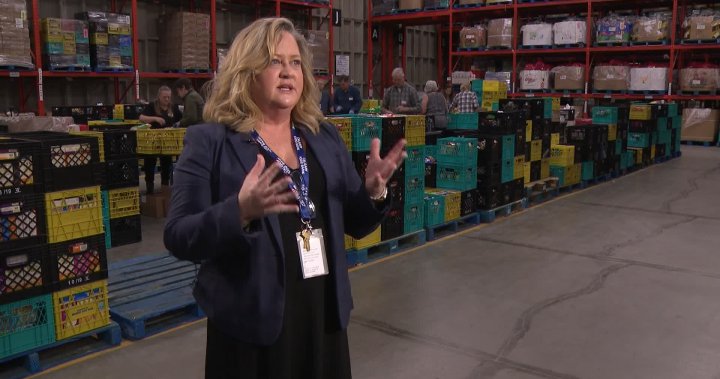General News
Calgary Food Bank demand high, wait time weeks long in face of food inflation

Food inflation continues to outpace overall inflation nationwide, with grocery prices hitting double-digit increases in 2022.
Tuesday’s inflation data from Statistics Canada showed overall inflation was slowing but in December, food prices were up 11 per cent on an annual basis.
That’s pushing more Calgarians to rely on the food bank.
“Unfortunately, business is booming,” said Calgary Food Bank spokesperson Shawna Ogston.
Read more:
Food prices slowed as overall inflation cooled to 6.3% in December
Read next:
Air Canada lost a man’s custom-built wheelchair, offers $300 voucher and broken replacement
And like other services in high demand, wait times have crept up.
“Unfortunately, there is a wait in order to get a hamper. It is about 10 to 14 working days,” Ogston said, noting the food bank has some reserves for people in crisis.
Demand for emergency food hampers have been on the rise for the past decade, with the food bank’s 2021-2022 annual report showing more than 112,000 hampers went out to Calgarian households. That number has doubled since 2012.
“Demand continues to be through the roof and we are helping more than 1,000 families and individuals every day with more than 500 hampers,” Ogston said.

“Our clients are everyday people, people that are working and still can’t make ends meet. And when everything is costing more and more every day, the only thing that people can actually manipulate in their budget is food. And they may not be making great choices.”
Global News spoke with Calgarians who have been feeling the impact of pinched pocketbooks, especially at grocery stores.
“Vegetables and fruits are too expensive for us because I have two kids and then I have to pack snacks every day,” Tomoko Oshima said. “But fresh fruits – it’s most important, but it’s quite expensive for us.”
Read more:
Budgeting ‘out the window’: How inflation is putting the squeeze on a B.C. single mom
Read next:
Mexico bans smoking in all public places, including beaches and hotels
With two children in tow, Chris Tucay carried a four litre jug of milk and a small fruit cup out of a grocery store to the tune of $10.
He said he’s had to make sacrifices to things like hobbies and work in the face of high food prices.
“You just have to pick basically what is necessary to survive day to day. Things that you don’t need – like going out for a fancy restaurant or something – maybe that’s something we could do it later on, but not right now,” Tucay said.
Lara Andrews, a mother of two in Calgary, counts her family lucky to be able to sidestep the cost of gasoline thanks to her husband’s job right now. But that wasn’t always the case.

A graph of price growth for food through December 2022, showing the 12-month per cent change.
Statistics Canada
“We have either had to go without eating ourselves or basically just get meals that are premade meals or tinned meals that aren’t always the healthiest and are filled with ingredients that do make people sick, just because it’s what’s affordable,” she told Global News. “There have been times in the past where we always put our children first — that we skipped meals to be able to afford for our children.”
And while Calgarians feel their food security eroding in the face of inflationary pressures, food insecurity has been a reality for more and more Canadians for at least a decade.
Tim Li, a research program coordinator at the University of Toronto’s food insecurity research program Proof, said studies of Statistics Canada data since 2013 show food insecurity has “persisted at a very high level.”
“Our latest report looked at food insecurity in 2021, where almost one in six households in Canada were food insecure, which means that they had inadequate access to food due to financial constraints,” Li said.
Read more:
Debt worries rise amid higher interest rates and persistent inflation: MNP report
Read next:
Used vehicle prices are dropping. Why you might want to hold off on your purchase
He suspects it’s gotten only worse.
“In the last year, we expect food insecurity to have worsened both in the prevalence and the number of people affected by food insecurity. So in 2021, that was about 5.8 million Canadians,” he said. “Their experiences have likely gone even worse, which means that they’re making more severe sacrifices to the food and other aspects of their life because they don’t have enough money.”
Andrews said her friends who are also parents are having to choose between driving to work and school or eating, because of inflationary pressures on food and gas. Her family’s experience with the food bank makes her empathize with those friends.
“The last time we used one was about three years ago when we were pregnant with my youngest daughter and they were great wonderful people, wonderful staff – I cannot commend the work they do highly enough,” Andrews told Global News. “Unfortunately, they’re also really overworked.”

Li said food banks, which have existed in Canada for more than four decades, are doing their best to support the community, but were only meant as a stop gap measure. And the University of Toronto researchers showed a direction between food insecurity and negative health outcomes, which cascades into a “really big burden” on the health care system.
“This problem of food insecurity is too big and has its roots in bigger issues of inadequate income, really the inadequacy of wages and social assistance programs, on income supports both federally and provincially and how they’re not enough for people to survive off of,” he added. “Our approach with these public safety net programs just hasn’t been enough.”
After three years of de-indexing the Assured Income for the Severely Handicapped (AISH) program, the Alberta government re-indexed AISH for 2023.
Li said indexing social assistance programs to inflation is a good start but more should be done.
Read more:
Recession will be ‘deeper’ than first thought, but job loss will be minimal: Deloitte
Read next:
Madonna world tour: Greatest-hits show to stop in 3 Canadian cities
“I think there needs to be a real conversation around making these benefits based on the actual cost of living that people are facing, so that we’re actually talking about programs that enable people to get by,” the U of T researcher said. “Another option that we can be really talking about is a basic income, something that allows us to create an income floor for all Canadians so that no one is finding themselves in a position where they are making compromises to basic needs like food.”
The Calgary Food Bank hasn’t seen this kind of demand in its 40 years. And Statistics Canada said food inflation is at levels not seen since 1981.
“It’s not about a lack of food. It’s about a lack of money to buy food. And the decision makers across the country have to look at what’s going on,” Ogston said
“The canary in the coal mine is the food banks.”
Andrews looks further back into history for comparisons.
“There comes a point where it becomes frightening and you wonder if there’s going to be a situation like the crash of 1929 again and a bag of flour is going to go up to $100 and nobody’s going to be able to afford to eat.”
— With files from Heather Yourex-West and Tomasia DaSilva, Global News
Disclaimer: No copyright infringement intended. All rights and credits reserved to respective owner(s).


























